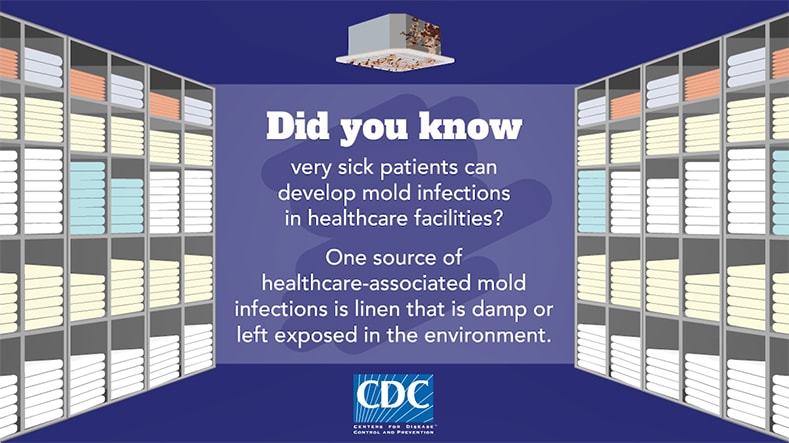At a glance
- People with weakened immune systems can get invasive mold infections (IMIs) from breathing in mold spores.
- Most people breathe in mold spores every day without getting sick.
- IMIs are rare but can be severe and life threatening.
- Risk for IMIs increases in healthcare settings and in areas affected by flooding.
- Preventing and cleaning mold growth in buildings will help protect people who are at risk.

Overview
People with weakened immune systems can get invasive mold infections (IMIs). These are mold infections that affect blood vessels, deep tissues, or organs. Most IMIs are caused by breathing in (inhaling) mold spores in the air. IMIs can also be caused by mold getting into the body through cuts or wounds or from contaminated medical equipment. The two most common types of IMIs are mucormycosis and aspergillosis.
IMIs are rare but cause severe, life-threatening illness. Mold lives in almost every indoor or outdoor environment, releasing spores into the air. Most people, including people with weakened immune systems, inhale mold spores without any negative health effects.
Who is at risk
Most people are not at risk for an IMI. People with weakened immune systems, often associated with health conditions and medical treatments, may be at risk. Some specific conditions and medical treatments that increase risk for IMIs include
- Organ, tissue, or stem cell transplants
- Cancer, especially blood cancers like leukemia and lymphoma
- Cancer treatment (chemotherapy)
- Corticosteroids and biologics
The risk of IMIs increases when people with weakened immune systems are in areas with high amounts of mold. This makes IMIs a public health concern after hurricanes and floods. There have also been outbreaks in healthcare settings.
Signs and symptoms
Signs and symptoms of IMIs can vary depending on
- Health condition(s) and severity before infection
- Route of exposure (inhalation or opening in the skin)
- Part of body affected
- Type of mold and amount of exposure
In general, symptoms often include
- Fever or night sweats
- Cough, shortness of breath, and sinus symptoms
- Weight loss
- Dark scabs, blisters, or ulcers on the skin
Prevention
It is not possible to completely avoid exposure to or inhalation of mold and mold spores. Preventing and cleaning mold growth in homes and buildings can help protect people who are at risk for IMIs.
If mold is seen, smelled, or otherwise known to be growing in a home or building, someone who is not at risk for an IMI should clean the mold. When possible, get help from an experienced and qualified professional. People with weakened immune systems should avoid being inside homes or buildings with mold until mold remediation is completed. Remediation is the process of cleaning to remove and reduce mold growth.
Hurricanes and floods
After a flood, mold can grow in homes and buildings if they are not dried out (including furniture) within 24–48 hours. It is not safe for someone with a weakened immune system to enter a moldy building.

Retrieving items from homes
People who evacuated a flooded area may need to retrieve belongings from their homes. People with a weakened immune system should not go into a moldy home. When officials say it is safe to go back into the area, someone who is not at risk for an IMI should collect belongings for them.
If that is not an option, any person with a weakened immune system should
- Talk to a healthcare provider first, if possible,
- Limit time inside to just retrieving what they need and leave right away, and
- Wear a properly fitted NIOSH Approved N95 respirator to reduce exposure.
Note:
An N95 respirator does not offer complete protection against exposure or infection.
Sheltering after a flood
Some people may not evacuate their area during a hurricane. They may have to remain in a home that became flooded and moldy. If possible, people at risk for IMIs should find alternative sheltering until the mold cleanup is complete.
If someone with a weakened immune system has no other options than to stay in a moldy home or building, they and members of their household should take these steps to reduce exposure. Only people who are not at risk should be involved in cleaning.
Outbreaks in healthcare facilities
Although rare, mold outbreaks can occur in healthcare facilities and cause severe illness and death among patients. Building construction, leaks, and laundry that is not properly handled can cause outbreaks. It is also possible to get an IMI from a contaminated tool or medical supply used in surgery.

Diagnosis and treatment
Diagnosing an IMI requires multiple diagnostic tests. Results of these tests should be interpreted in the context of each specific patient. These tests include:
- Culture of specimens from the affected area.
- Bronchoalveolar lavage (BAL), which is often used to detect lung infections.
- Determining fungal culture and histopathology from biopsy.
- Imaging (e.g., chest computed tomography [CT] for respiratory symptoms).
- Blood tests (such as Aspergillus galactomannan), which are primarily used in patients with weakened immune systems.
Starting treatment early can help prevent deaths. Treatment includes antifungal medications and, in some cases, urgent surgery. Antifungal therapy may be required for weeks to months. These medications may have side effects but can be lifesaving. Consider talking to an infectious disease specialist to help with diagnosis and treatment.
